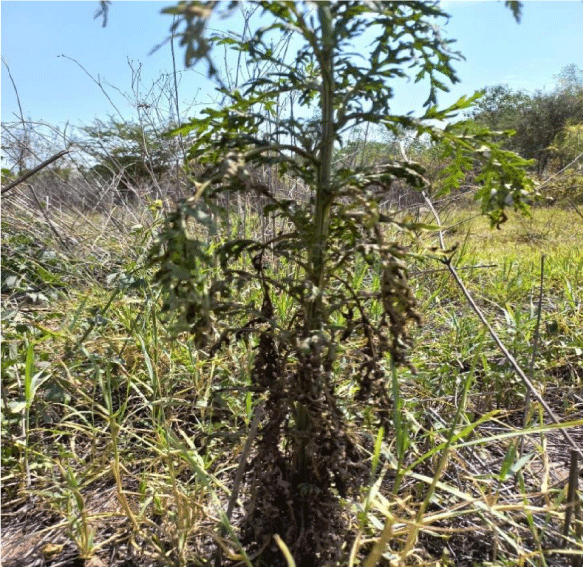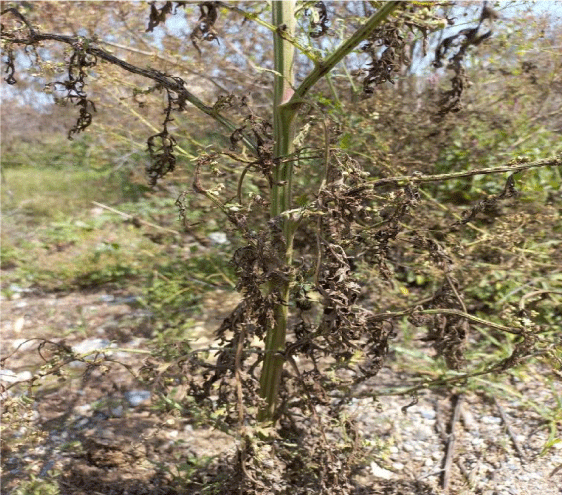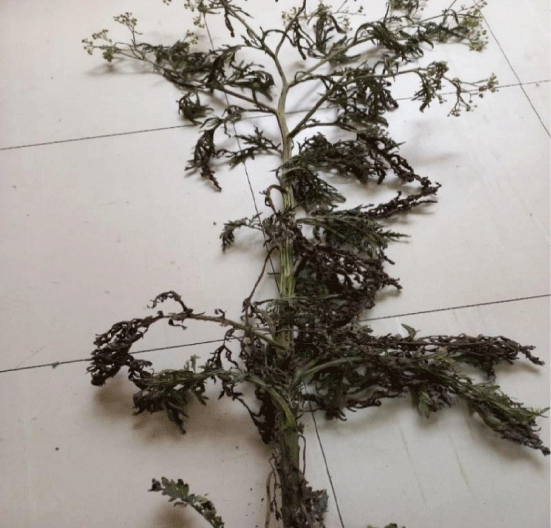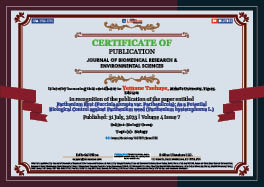Biology Group . 2023 July 31;4(6):1166-1169. doi: 10.37871/jbres1782.
Parthenium Rust (Puccinia abrupta var. Partheniicola): As a Potential Biological Control against Parthenium weed (Parthenium hysterophorus L.)
Yemane Tsehaye* and Tesfakiros Semere
Abstract
Parthenium (Parthenium hysterophorus L.), the invasive weed of global significance, have a direct and indirect impact on human and animal health as well as the overall ecosystem health. Since its introduction to Ethiopia and the Tigray region, it rapidly covers millions of hectares of crop fields. Different biological control options were tested in many countries including Ethiopia, that ranging from fungus inoculation to the introduction of insect pests (bioagents) and two bioagents, the leaf-feeding beetle (Zygogramma bicolorata) and stem-boring weevil (Listronotus setosipennis) were reported to have better performance. Nevertheless, susceptibility of the bioagents to weather variability and predators were among the important factors that halts the effectiveness of the bioagent based biological control. In the Tigray region, the native pathogen, parthenium rust(Puccinia abrupta var. partheniicola) showed very promising effect against the noxious weed, parthenium, and proved to be reliable. In field condition, disease incidence that ranges between 20-100% was observed. As a result of the pathogenicity effect of the parthenium rust, symptoms like leaf and flower defoliation, chlorosis, necrosis, and stunted vegetative growth, and failure of seed production have been portrayed. The future use of uredospore suspensions of the parthenium rust as foliage application and as a mycoherbicide, and development of tolerant crop varieties via breeding are discussed.
Background
Parthenium (Parthenium hysterophorus L.), a dangerous weed of global significance, native to regions in south America [1], that has spread to over 46 countries and territories [2,3], may be introduced to Ethiopia during the Ethio-Somali war, before four decades that likely via heavy military vehicles as well as wind and contaminated grain trade [4]. Parthenium is considered as the most hazardous invasive plant species, in Ethiopia and elsewhere in Africa as well as Asia. The direct and indirect impact of Parthenium on crop and livestock production, ecosystem and biodiversity (including loss of species richness [5]), animal and human health was documented [6,7]. Parthenium produces toxic substances that are lethal to humans as well as animals, that cause respiratory problems including allergy and asthma [6]. It also affects the quality of animal products, meat and milk quality [8].
Parthenium in the Tigray region
Since the last 20 years, where parthenium was first spotted in the southern part of Tigray, it has spread rapidly throughout the Tigray region (including the Tigray capital, Mekelle), with no natural predators. The noxious weed species covers several square kilometers of Tigrayan farms, with an annual growth rate of more than five percent. In the southern part of Tigray, Alamata area, more than 10,000 hectares of sorghum farms have been infested with Parthenium. The aggressive growth habit of the species coupled with a deep taproot system, and prolific flowers creates a significant challenge for agricultural production and city sanitations.
It was unfortunate that during the recent Ethiopia’s war on Tigray (‘war on humanity’), where the whole Tigray region was under a complete siege for more than two years (people deprived of food, medical care, banking, electric power, communication and so on), where farms seldom provide food (due to wide scale displacement or availability of limited farm inputs, including deliberate damage and burning of grain piles and farming tools), the Tigrayan people particularly the poor, must pass through the worst scenario in the 21st century, and that withstand periods in which nothing can be gleaned from the soil or granaries. Many desperate families were spending several days without food, a common phenomenon at the time, people were in search of edible leaves from the forest area and indigenous roots, vegetables and wild fruits from field and mountain edges to fill the longer gaps in the dietary continuum. However, the only available and standing plant species (that invaded farms and road edges) during the terrible war situation (particularly during the dry off-season) was only parthenium, the toxic plant, that cannot be utilized as food staff, and in fact at the time, the weed was in a progressive damage by the rust species (Puccinia abrupta var. partheniicola) [see plates below]. It has an interesting similarity with the biblical story of the fig tree (Mark 11: 12, New King James Version) that when Jesus was hungry and come to the fig tree for searching a fruit, he found nothing but leaves, and in response, Jesus said, ‘let no one eat fruit from you ever again’, and consequently the cursed fig tree has ‘withered away’. As a result of the dreadful war on Tigray and subsequent loss of food sovereignty, starvation was portrayed in the Tigray region, and many people (according to the USAID report, above 85% of the population) were placed at the brink of famine like starvation.
Biology and adaptation of the weed
Parthenium, an herbaceous invasive weed, also called as congress weed and famine weed [9], is a rapidly growing annual, in a moist and warm condition, it can germinate and grow at any season of the year [10]. It can grow into a height of 2m and a matured plant can produce from 12,000 - 28,000 seeds [11,12]. According to Butler JE [13], the seeds of the noxious weed, Parthenium, can stay longer in the soil, and remained viable for more than two years without exhibiting dormancy [14]. Parthenium is tolerant to low as well as excess moisture and prolifically grown during the off-season when other plant species particularly shrubs and grasses collapsed due to limited moisture and high temperature. It springs up during the main as well as off-season, with surprising vigor from the tiny and plenty seeds. Parthenium is easily grown and tolerates a wide range of soil types, including acidic and alkaline soils. It survives on barren areas and has tolerance to abiotic stresses including pests and major diseases, and it is only recently become susceptible to rust infestation.
Economic importance
Parthenium which invaded more than two million ha of grazing and crop land in Ethiopia [2], that critically puts the ecosystem (including agriculture) as well as human health at risk. In Ethiopia, parthenium is reported as an important weed in vegetables, maize, sorghum fields. In the latter (sorghum), particularly in eastern Ethiopia, depending on the season and location, 40 to 97% yield loss was reported [4]. Parthenium damage results not only in direct competition (for resources and space) but also it disrupts the quantity and quality of nearest crops due to its allelopathic effect that inhibits the growth of other economical important crop species. As a result of its allelopathic effect, failure of seed germination in Eragrostis tef [15] and loss of seed germination and elongation in onion and beans [16] in Ethiopia were also reported.
Biological control: Bioagents
Different biological control options were tested in many countries including Ethiopia, that ranging from fungus inoculation to the introduction of insect pests (bioagents). To combat and disrupt parthenium expansion in Ethiopia, two bioagents, the leaf-feeding beetle (Zygogramma bicolorata) and stem-boring weevil (Listronotus setosipennis) were introduced from abroad and locally released. These two bioagents were reported to be host specific [11] and feeding (and/or oviposition) on nearby economically important crops (such as tef and faba bean) were not reported. In Australia, of the six insects (bioagents) released, the larva of the moth Epiblema strenuana reported to exert a significant control on Parthenium [17]. However, the outcome of bioagent based parthenium control effort seems only partial and inadequate [11]. Susceptibility of the bioagents to weather variability and predators were among the important factors that halts the effectiveness of the bioagent based biological control in the field. Besides, the feeding and oviposition effect of the bioagents in economically important crops like the Niger seed (Guizotia abyssinica [L.]) reported in India [18], created much concern on the use of bioagents. Thus, searching for endemic pathogens (particularly rust) that tolerates weather variability and predation (both by birds and ants) and that requires no quarantine measures [19] and entry/exit permits, deemed important.
Biological control: Case study on the use of rust as pathogen
Several parthenium management options are available, that ranging from mechanical to chemical based control [20]. The need of repeated application of chemicals and the associated environmental pollution concern as well as high cost and the associated health concern with mechanical (physical as well as cultural methods) control and high labor cost, may preclude effectiveness of both methods in parthenium control over large areas. Biological control is therefore, considered as economical and effect approach against parthenium [20]. However, the bioagent based biological control efforts on parthenium control, may not considered as a success [11], as the time needed to establish a bioagent in a given locality (and/or season) as well as the vulnerability to weather variability and predation, limits its success. McFadyen RE [8] and Dhileepan K [20] noted that the use of parthenium rust (Puccinia abrupta var. partheniicola) in parthenium control proved to be reliable.
To explore for the incidence of native pathogens against the noxious invasive weed (parthenium), a field survey was undertaken around Mekelle, Tigray and its environs, and the team has discovered that parthenium has been threatened to the level of locally elimination by a parthenium rust (Puccinia abrupta var. partheniicola). Rust (Puccinia abrupta var. partheniicola) infected parthenium plants were recorded in 3-5 km distance intervals and the level of disease incidence and severity was documented. Disease incidence was more frequent in the altitude range of 1900 – 2200 masl and disease incidence that ranges from 20 -100% was observed (see the plates given below). As a result of the pathogenicity effect of the parthenium rust, symptoms like leaf and flower defoliation, chlorosis, necrosis, and stunted vegetative growth, and failure of seed production have been portrayed. In other parts of the country, up to 42% reduction in seeds per plant was reported [8]. As a way forward, the foliage application of uredospore suspensions from 3-week-old pustules of the rust and the use of the rust fungus as a mycoherbicide are of top priority. Host specificity test of Puccinia abrupta var. partheniicola on economically important crops would also be investigated. The possibility of development of tolerant crop varieties against the weed and the use of molecular markers for mapping the pathogen distribution and estimation of level of genetic diversity will be explored.
Competing of Interest
The authors declared that they have no competing interest for this article.
Authors’ Contributions
Both authors have equal contribution in data collection and write-up.
References
- Picman J, Picman AK, Autotoxicity in Parthenium hysterophorus and its possible role in control of germination. Biochemical Systematics and Ecology. 1984;12(3):287-292.
- Adkins S, Shabbir A. Biology, ecology and management of the invasive parthenium weed (Parthenium hysterophorus L.). Pest Manag Sci. 2014 Jul;70(7):1023-9. doi: 10.1002/ps.3708. Epub 2014 Jan 24. PMID: 24430973.
- Mao R, Shabbir A, Adkins S. Parthenium hysterophorus: A tale of global invasion over two centuries, spread and prevention measures. J Environ Manage. 2021;279:111751.
- Tamado T, Milberg P. Weed flora in arable fields of eastern Ethiopia with emphasis on the occurrence of Parthenium hysterophorus. Weed Research. 2000;40:507-521.
- Boja M, Girma Z, Dalle G. Impacts of Parthenium hysterophorus L. on Plant Species Diversity in Ginir District, Southeastern Ethiopia. Diversity. 2022;14:675.
- Singh HP, Batish DR, Pandher JK, Kohli RK. Assessment of allelopathic properties of Parthenium hysterophorus residues. Agriculture, Ecosystems & Environment. 2003;95:537-541.
- Mirza H, Masum SM, Ali MH. Treats of Parthenium hysterophorus on agro- ecosystems and its management: a review. International Journal of Agriculture and Crop Sciences. 2013;6(11):684-697.
- Taye T, Hoppe B, Janke J, Henniger T, Gossmann M, Von Bargen S, Bandte M, Ulrichs C, Büttner C. Parthenium Weed (Parthenium hysterophorus L.) Research in Ethiopia: Investigation of Pathogens as Biocontrol Agents. Ethiop J Agric Sci. 2010;20:107-127.
- Al Ruheili AM, Al Sariri T, Al Subhi AM. Predicting the potential habitat distribution of parthenium weed (Parthenium hysterophorus) globally and in Oman under projected climate change. Journal of the Saudi Society of Agricultural Sciences. 2022;21:469-478.
- Navie SC, McFadyen REC, Panetta FD, Adkins SW. The biology of Australian weeds 27. Parthenium hysterophorus L. Plant Prot. 1996;11:76-88.
- McFadyen RE. Biological control against parthenium weed in Australia. Crop Protection. 1992;11(5):400-407.
- Nguyen TLT, Bajwa AA, Navie SC, O’Donnell C, Adkins SW. 2017. The Soil Seedbank of Pasture Communities in Central Queensland Invaded by Parthenium hysterophorus L. Rangeland Ecology and Management. 2017;70(2):244-254.
- Butler JE. Longevity of Parthenium hysterophorus L. seed in the soil. Aust Weeds. 1984;3:6.
- Williams JD, Groves RH. The influence of temperature and photoperiod on growth and development of Parthenium hysterophorus L. Weed Res. 1980;20:47-52.
- Tefera T. Allelopathic effects of Parthenium hysterophorus extracts on seed germination and seedling growth of Eragrostis tef. Journal Agronomy Crop Science. 2002;188:306-310.
- Demissie AG, Ashenafi A, Arega A, Etenash U, Kebede A, Tigist A. Effect of Parthenium hysterophorus L. on germination and elongation of onion (Allium cepa) and bean (Phaseolus vulgaris). Research Journal of Chemical and Environmental Sciences. 2013;1(2):17-21.
- McClay AS. Observations on the biology and host specificity of Epiblema strenuana (Lepidoptera, Tortricidae), a potential biocontrol agent for Parthenium hysterophorus (Compositae). Entomophaga. 1987;32:23-34.
- Jayanth KP. Investigations on the host-specificity of Epiblema strenuana (Walker) (Lepidoptera: Tortricidae), introduced for biological control trials against Parthenium hysterophorus in India. J Biol Control. 1987;1:133-137.
- Quimby PC, Walker HL. Pathogens as mechanism for weed management. Weed Science. 1982;30:30-34.
- Dhileepan K. Seasonal variation in the effectiveness of the leaf-feeding beetle Zygogramma bicolorata (Coleoptera: Chrysomelidae) and stem-galling moth Epiblema strenuana (Lepidoptera: Tortricidae) as biocontrol agents on the weed Parthenium hysterophorus (Asteraceae). Bull Entomol Res. 2003 Oct;93(5):393-401. doi: 10.1079/ber2003255. PMID: 14641978.
Content Alerts
SignUp to our
Content alerts.
 This work is licensed under a Creative Commons Attribution 4.0 International License.
This work is licensed under a Creative Commons Attribution 4.0 International License.











